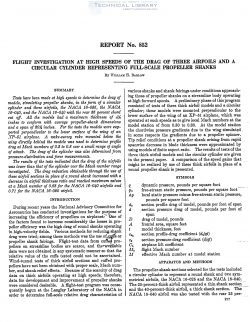naca-report-852

- Version
- 181 Downloads
- 685.20 KB File Size
- 1 File Count
- August 31, 2016 Create Date
- August 31, 2016 Last Updated
National Advisory Committee for Aeronautics, Report - Flight Investigation at High Speeds of the Drag of Three Airfoils and a Circular Cylinder Representing Full Scale Propeller Shanks

Tests have been made at high speeds to determine the drag of
models, simulating propeller shanks, in the form of a circular
cylinder and three airfoils, the NACA 16—035, the NAC’A
16—040, and the NAC’A 16—040 with the rear 25 percent chord-
cut of. All the models had a maximum thickness of 4%
inches to conform with arerage propeller-shank dimensions
and a span of 20% inches. For the tests the models were sup-
ported perpendicular to the lower surface of the wing of an
YP—51 airplane. A wakesurrey rahe mounted below the
wing directly behind the models was used to determine profile
drag at hfach numbers of 0.3 to 0.8 over a small range of angle
of attack. The drag of the cylinder was also determined from
pressure-distribution and. force measurements.
The results of the tests indicated that the drag of the airfoils
was lower than that of the cylinder orer the Mach number range
investigated. The drag reduction obtainable through the use of
these airfoil sections in place of afound shank increased with a
decrease in airfoil thickness ratio and reached maximum values
at a hfach number of 0.63 for the NAOA 16—040 airfoils and
0.71 for the NAC’A 16—025 airfoil.
During recent years the National Advisory Committee for
Aeronautics has conducted investigations for the pur se of
increasing the efliciency of propellers on airplanes:' e of
the factors found to increase considerably the losses 1n pro-
peller efficiency was the high drag of round shanks operating
in high-velocity fields Various methods for reducing. shank
drag were tried; among these methods was the use of; s or
propeller shank fairings. Flight-test data from cufhsi pro-
pellers on streamline bodies are scarce, and therava‘llable
data were not. obtained in any systematic manner so that the
relative value of the cuffs tested could not be ascertained.
Wind-tunnel tests of thick airfoil sections and cufied pro-
pellers have not been obtained with proper scale, Mach num-
ber, and shank relief efiects.
| File | Action |
|---|---|
| naca-report-852 Flight Investigation at High Speeds of the Drag of Three Airfoils and a Circular Cylinder Representing Full Scale Propeller Shanks.pdf | Download |

Comment On This Post